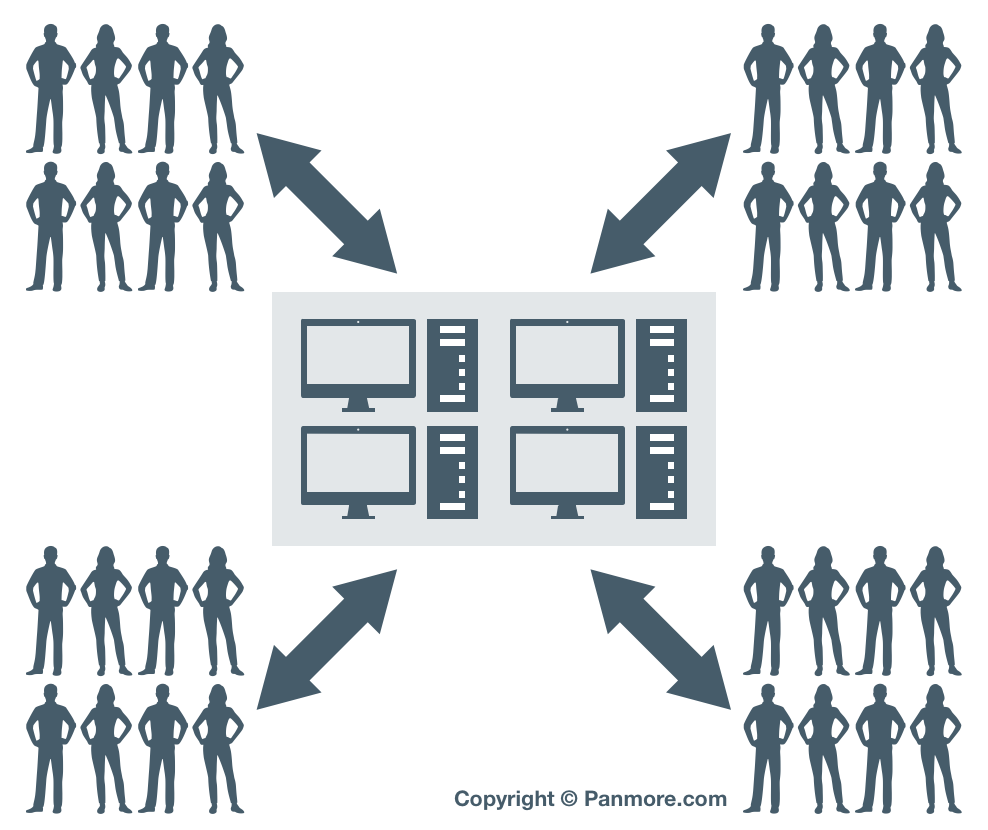
Business information systems (BIS) design can help address silo mentality in organizations. Silo mentality is a common occurrence in companies, especially large ones that have a wide variety of functions, divisions, and employee groupings. With this mentality and its associated behaviors, workers tend to keep information to themselves or their team, and prefer not to share information with other teams or groups in the organization. As a result of silo mentality, business organizations experience difficulties in optimizing the benefits of business data and related information. For example, employees are unable to maximize their productivity when information access is inadequate – a condition partly linked to silo mentality. The resulting condition creates challenges in maximizing the benefits of business intelligence throughout the organization. In virtual organizations, silo mentality occurs in relation to the lack of face-to-face communication, as well as other factors in management, training, information technology tools, and business design. Despite these issues, companies can use business information systems design to reduce or prevent silo mentality in their human resources.
The prevalence of information technologies in businesses makes BIS design a major factor in addressing silo mentality. The characteristics, availability, degree of adoption and use, and strategic and managerial support for business information systems influence companies’ ability to limit the negative consequences of silo mentality in their organizations. Strategic management and related strategic plans focused on optimizing human resource performance must include measures for ensuring that business information systems are designed and used to suit the specific needs of the business, while maximizing communication and information sharing effectiveness and efficiency.
Silo Mentality and Associated Factors in Business Organizations
With regard to business information systems, technological support for internal communications is among the main concerns pertinent to the issue of silo mentality. Many factors, such as psychological variables, contribute to the occurrence of silo mentality in companies. However, these factors usually relate to some form of information technology or technological tools used for communication. Thus, the technological aspect of communication is significant in business strategic management for understanding and solving the problem of silo mentality.
Managerial support for information sharing. Leaders’ and managers’ support influences how employees actually share information, and how silo mentality occurs. In corporations where leaders’ behaviors are examples of prudent information sharing for the purpose of business development, employees are likely to engage in similar activities where they share information with each other, with the objective of supporting business improvement. Situations where leaders and managers lack support for information sharing create opportunities for the occurrence of silo mentality. Managers need to embody the importance of information sharing, to exhibit exemplary behavior that encourages the company’s human resources to support the sharing of valuable business data and information.
Availability of tools for information sharing. Workers use tools to share information. Aside from leadership support, employees need the right tools to effectively and efficiently share information to benefit the business organization. For example, a company with an e-commerce arm, such as Home Depot, needs the right information technologies to facilitate communication and information sharing among employees in various locations. The lack of appropriate communication tools hinders information sharing and creates a condition conducive to silo mentality among the workers. Employees could view this technological inadequacy as a sign of organizational acceptance of or tolerance to silo mentality and related problematic behaviors. Thus, it is essential that business organizations implement appropriate tools for information sharing in order to reduce the risk of silo mentality.
Other factors. Organizational size is another factor that influences the probability of silo mentality in companies. Larger organizations tend to experience higher risks of this mentality because of their higher number of groupings or divisions. For example, a large corporation like General Motors uses many teams and departments for various functions, including research, design, manufacturing, and marketing. Such an organizational structure and its complexity hinder information sharing and increase the probability of silo mentality. In relation, internal competition among groups discourages information sharing. As a result, internal competition is a psychosocial factor that increases the occurrence of silo mentality in business organizations. Moreover, a company’s organizational culture influences how workers perceive and support information sharing strategies to prevent silo mentality.
The Role of Business Information Systems in Internal Business Communications
Business information systems provide organizations with tools and capabilities for maximizing the value of data and related information. For example, large companies like Facebook, Google, Amazon, Unilever, and Walmart use business information systems to support effective communication among personnel, and to analyze and understand their customers and markets. In the context of internal business communications, BIS facilitate communication among individual employees and departments. Workers use various tools in the business information system to share information, such as in escalating concerns to higher management, and in project-specific collaboration.

The type and characteristics of business information systems depend on their application and purpose in the organizational context. For example, management information systems support corporate executives’ use of business intelligence. Human resource information systems (also known as HR management systems) facilitate HR programs and policies, such as in the analysis of human resource capabilities, development, and actual performance. Production information systems are used to maintain the efficiency of manufacturing firms’ operations, while enabling the identification of potential issues in production. There are many other types of information systems based on their kinds of users or based on their target business areas or functions. All of these business information systems support internal communications and, thus, influence the probability of silo mentality.
Designing Business Information Systems to Reduce and Prevent Silo Mentality
The critical function of business information systems in organizations’ internal communications means that BIS design influences the effectiveness, efficiency, and frequency of internal communications. Thus, to reduce the occurrence of silo mentality, companies must ensure that their BIS design suits their business needs and encourages information sharing among employees. With this condition in mind, the following are some recommendations in designing business information systems to manage the problem of silo mentality in the workplace:
Optimize tools for information accessibility throughout the business organization. The availability of tools influences the effectiveness and efficiency of information access. For example, it is easier for employees to access information from other departments when there are tools specifically designed for this purpose, and integrated into the current business information systems. These tools encourage workers to communicate and share information, and reduce the probability of silo mentality in the organization. With these considerations in mind, it is prudent to ensure that organizational development strategies include the provision of tools for information access, as an approach to reduce the problem of silo mentality.
Implement channels for mutual sharing of information. The availability and appropriateness of communication channels determine the actual effectiveness of tools for information access. Even when the right tools are available, the lack or inadequacy of these information-sharing channels could reinforce silo mentality. For example, team members who have tools for sharing information are likely to keep that information to their team when inter-team communication channels are absent. Thus, with the goal of reducing or preventing silo mentality, managers need to ensure that the business organization has the right channels to facilitate information sharing among teams or divisions.
Minimize bottlenecks in information access. Bottlenecks restrict or slow down the flow of information in communications channels. Human intervention is one of the common factors that create bottlenecks. For example, information sharing slows down when information needs to go through an officer’s manual checking or approval in the company’s business information system. Also, the technological design of the BIS could create bottlenecks, such as in cases where employee access portals are not optimized to handle multiple simultaneous accesses. In this regard, an approach to prevent or minimize silo mentality is to design information systems for optimized simultaneous access and sharing of information among all relevant individuals and groups in the business organization.
Train and develop employees to use BIS for information sharing. Employees’ knowledge, skills and abilities in using business information systems influence the occurrence of silo mentality. This human resource factor addresses the technological skills needed in using business information systems. A worker needs the right skillset to use tools integrated in the BIS. To reduce or prevent silo mentality, companies must support corresponding human resource development to optimize BIS utilization. Part of the strategy for addressing silo mentality should be to provide training and development programs to ensure that employees have the right skills for using communication and information sharing tools, especially in recently upgraded business information systems that include new technologies.
Keep business information systems up to date. The rapid development of information technologies requires companies to regularly update their systems. Keeping business information systems up to date optimizes technological capabilities and efficiencies, and supports business competitiveness, based on the assumption that competitors also keep their information systems up to date. Also, up-to-date business information systems typically come with solutions to bugs, which could contribute to silo mentality by reducing the effectiveness and efficiency of information sharing. As part of strategies to address silo mentality, companies must have policies to upgrade and update their systems regularly or when appropriate.
Maintain a responsive organizational system for addressing issues in using BIS. Even when they are always up-to-date, business information systems could still present issues and problems. For example, new bugs could reduce these systems’ effectiveness and prevent workers from sharing information efficiently. In addition, workers may experience difficulties in using new tools in BIS that have just been upgraded or updated. These usage problems could pave the way for silo mentality. Strategies for addressing these problems should involve business processes, training programs, and IT support that aim to immediately respond to usage issues of business information systems. Immediate response and overall responsiveness in optimizing business information system usage contribute to efficient communication and the reduction of the likelihood of silo mentality in the organization.
References
- Abedalla, R. W. (2014). The silo effect of information technology on the organizational productivity: A qualitative research study. International Journal of Computer, 15(1), 42-50.
- Barata, J., & Cunha, P. R. (2017). Synergies between quality management and information systems: A literature review and map for further research. Total Quality Management & Business Excellence, 28(3-4), 282-295.
- Cilliers, F., & Greyvenstein, H. (2012). The impact of silo mentality on team identity: An organisational case study. SA Journal of Industrial Psychology, 38(2), 75-84.
- De Waal, A., Weaver, M., Day, T., & van der Heijden, B. (2019). Silo-busting: Overcoming the greatest threat to organizational performance. Sustainability, 11(23), 6860.
- Quirke, B. (2017). Making the connections: Using internal communication to turn strategy into action. Routledge.
- Schmidt, R., Möhring, M., Bär, F., & Zimmermann, A. (2017, June). The Impact of Digitization on Information System Design-An Explorative Case Study of Digitization in the Insurance Business. In International Conference on Business Information Systems (pp. 137-149). Springer, Cham.
- Wright, M., & Robertson, F. (2016). Creating an internal communication strategy. In Gower Handbook of Internal Communication (pp. 43-72). Routledge.
- Yehya, N. A., & Coombs, W. T. (2017). Catalytic defiance as a crisis communication strategy: The risk of pursuing long-term objectives. Business Horizons, 60(4), 463-472.
